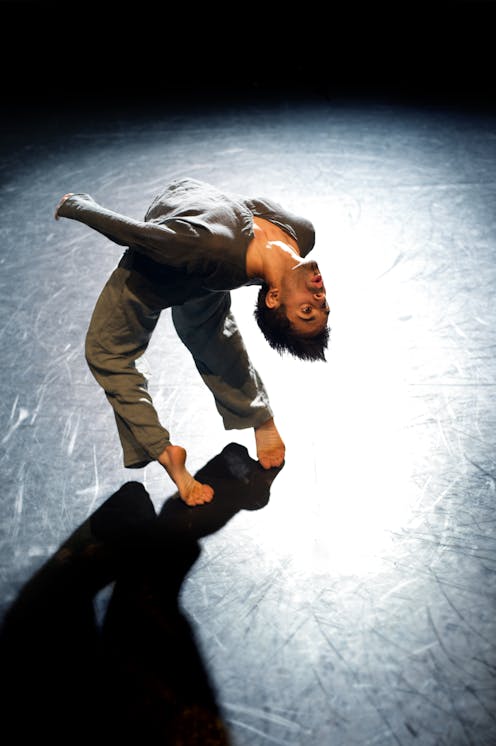Classical Indian dance meets contemporary in Rising
- Written by William Peterson, Senior Lecturer in Drama, Flinders University

British dancer Aakash Odedra’s debut solo evening of work, collectively presented under the title Rising, was a fitting and provocative bookend to this year’s OzAsia Festival. It harked back to the festival’s thrilling opening production of Until the Lions by the Akram Khan Company.
Like Khan, Odedra is of South Asian heritage — though Indian rather than Bangladeshi — and relies on training in the classical dance form of Kathak and the neoclassical form of Bharatanatyam to underpin the movement of his contemporary work. But, unlike Khan, Aakash as a solo artist possesses a uniquely graceful elegance, in marked contrast with the powerful movements of the stockier and generally quite grounded Khan.
Odedra is capable of shifting from rapid-fire footwork so fast he appears to be levitating, to a series of whirling dervish-type spirals that propel him across the stage, to gorgeous, fluid articulations of his arms and hands, then moving into steps so elegant one might imagine he is conjuring the spirit of Fred Astaire, gliding, not just dancing across the floor. Dressed in loose-fitting white clothing derived from the traditional dhoti with trousers, his moves are confident, precise, fluid and frequently unexpected.
The program consisted of four works by different choreographers. The first was the dancer’s own piece, Nritta, clearly derived from the Kathak dance form.
As the only work that followed the 16-beat time cycle found in classical Indian music, it served as a fitting point of entry to the evening. It moved from the austerely devotional to spectacular, virtuosic displays of flight across the stage. Odedra’s eloquent hand and arm gestures, as rapid as liquid, were held only when dramatic necessity seemed to call for it, offering us a kind of uniquely deconstructed Kathak style.
The second dance, In the Shadow of Man, choreographed by Akram Khan, had much of the power and drama associated with his work. Odedra’s unique capacities were remarkably and superbly utilised.
In Michael Hulls’ brilliant chiaroscuro lighting, Odedra materialised before us, not in human form, but as a kind of disembodied torso, initially with what appeared to be tiny hands crawling across his back. His slender form and extraordinarily expressive shoulder blades drew out movements that seem to be those of a new, non-human species, placing the audience in a nearly hallucinatory state.
In both this work as well as the following piece, Cut, choreographed by Russell Maliphant, Odedra’s sensuous arm extensions and expressive hands were key choreographic elements.
Hulls’ superb lighting in Cut enabled Odedra to dance with his hands only at times. Laser-focused white light illuminated his hands, creating the illusion that they were glowing. A kind of visible, dark force field of shadows extended from them to the floor below, creating a kind of uncanniness.
In terms of sheer ingenuity, the final work, Constellation, choreographed by Sidi Larbi Cherkaoui and lit by Willy Cessa, was an absolute standout. It brought the evening to an appropriate, gentle close.
Odedra performed with a series of light globes hanging down from above the stage, activating them as he went. The lights moved sideways in darkness, then up and down. At times they appeared to make a pattern, though one wondered if the pattern was being created by the mind’s eye.
As the work drew to a final coda Odedra carried a single globe, lit brighter than the others and causing them to be extinguished. The spare, emotional music by Olga Wojciechowska briefly stopped and, while focused on Odedra’s eloquent moving arms and hands, we were plunged into stillness and silence, with the sound of our collective breathing connecting us to one another.
The work ended as Odedra dissolved into a sea of blinking lights, resetting our emotional clocks and bringing us back to the source of something deeper than ourselves.
Rising was staged as part of the OzAsia Festival.
Authors: William Peterson, Senior Lecturer in Drama, Flinders University
Read more http://theconversation.com/classical-indian-dance-meets-contemporary-in-rising-85392



